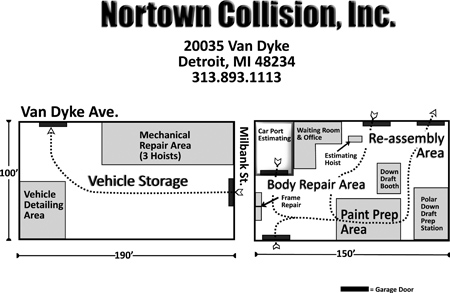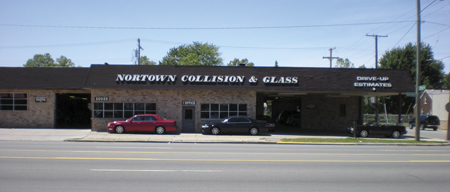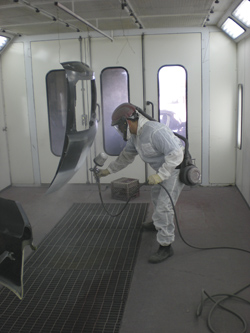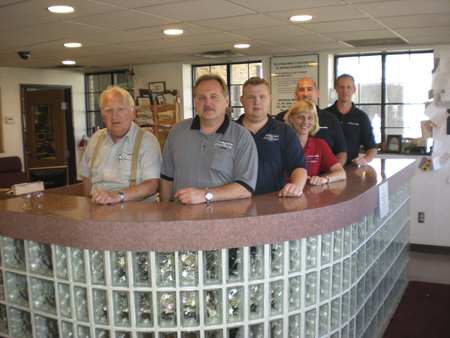Nortown serves have evolved over the years, so too has the shop.
“You can’t be too comfortable for too long because things are always changing,” says Allen Oleszko, Nortown co-owner and the second of three generations of the Oleszko family working at the shop.
Nortown was founded in 1948 by Al’s father, Eugene Oleszko, and Al’s Uncle Henry. Eugene, now 82, still works at the shop every day. Al’s sister, Kathleen Best, son, Al Jr., and nephew, Ron Best, round out the family equation. Everyone but Eugene started out “pushing the broom around the shop” and learned the business from there, Oleszko says.
After six expansions to the original shop, Nortown’s 34,000-square-foot facility now includes a main building housing the body shop and office areas and an additional building for Nortown’s detailing, mechanical repair and storage facilities.
Despite its growth throughout the years, the northern Detroit shop hasn’t been immune to the staggering economy, which has been especially tough on the Motor City. To stay in business, Oleszko says he has had to make cuts behind the scenes while working to maintain the shop’s quality standards. Luckily, a loyal group of dedicated employees and three generations of faithful customers have made the choices a little easier.
| Nortown Collision |
| Location: Detroit, Mich. Established: 1948 Square Footage: 34,000 Owner: Oleszko family No. of Employees: 12 – 4 body techs, 2 painters, 1 detailers, 3 estimators/office staff, 1 shop foreman, 1 mechanic Gross Sales: $1.8 million Repair Volume/No. of Cars Per Month: 60 Average Repair Cost: $2,600 DRPs: 4 |
Ditching the Discounts
DRP relationships can be a blessing or a burden for a body shop depending on the contract, and Oleszko said the eight DRP contracts Nortown held as of last year were an equal mix of both. So, in an effort to preserve its bottom line, Nortown eliminated half of its DRPs. Oleszko says the concessions required by some insurers combined with decreased workloads made it impossible to profit from the relationships any longer.
“The discounts were just adding up to enormous amounts, and the insurance companies more or less wanted us to do more and more without the workflow that they used to give us,” he said. “We had to make a decision that this is what we need to do to stay in business.”
Oleszko says Nortown dropped two DRPs that required “heavy discounts.” The most recently dropped of the two was with an insurer that was providing a poor workload but requiring a 10-percent parts discount and a $2 an hour labor rate discount. Nortown’s DRP that provided the best workload, State Farm, required a match on that rate, but asked for no discounts otherwise. Once the discounted DRP was dropped, State Farm immediately began paying the prevailing labor rate and full price for parts, Oleszko says.
Another company required Nortown to subscribe to an additional estimating system not normally used in the shop, another cost that in the end wasn’t worth keeping the DRP contract for.
After dropping its four poorly performing DRP contracts, the four insurers for which Nortown has a DRP – State Farm, Esurance, GMAC and MetLife – don’t require any parts or labor rate discounts. At a time when claims are down “drastically” anyway, Oleszko believes dropping the discounted DRPs was easier than it would have been during a business boom. Oleszko says he’s lost some customers because of cuts, but many decided to continue doing business with the shop.
“We targeted those customers and made them aware we no longer have DRP agreements with their insurers,” he said. “But we told them we can still give you great service – probably better service – since we don’t have to meet discount requirements, and we’ve retained a lot of that customer base.”
Lights Out
The DRP decision was a big one for Nortown, but Oleszko says the shop also works every day on little things that help keep costs down. Building maintenance is done in-house, lights are turned off at lunchtime and the thermostat is dialed down overnight in the winter.
“We have a meeting with our employees every week and ask, ‘What can we do to cut our costs?’” Oleszko says.
Oleszko’s sister, Kathleen, also regularly analyzes the shop’s expenses to find ways to save. The small things Nortown employees do every day have added up: In the past year, the shop has cut its energy costs by one-third.
Quality Over Quantity
Despite the Oleszko family’s best efforts, the crashing economy has meant about a 30 percent drop in business at Nortown and the need for less staff. But instead of cutting the most experienced and highest-paid employees, Nortown opted to drop its less experienced staff: a body tech, a combination body tech and mechanic, and one estimator.
But Oleszko wouldn’t have been able to make the decision without the support of Nortown’s crew, who had to make personal sacrifices to hold onto their jobs.
“The trend is to eliminate the old, long-time employees and hire new at a lower rate,” he said, noting that several employees have stuck with the shop between 20 and 40 years. “My employees realized that and were willing to take pay cuts to help the situation we have here.”
Although he’s had to cut staff, Oleszko says he believes in investing in training, and Nortown’s six body techs and two painters are I-CAR Gold Class certified, and the crew also recently completed a course on hybrid vehicle technology.
Nortown’s painters – Ron Best and Dan Fish – also have access to Michigan-based Transtar’s newest products for topcoats and undershields, which the shop uses in tandem with DuPont Chroma colors. Transtar uses Nortown as a proving ground for many of its new products, Oleszko says.
“My two painters are so conscientious about their work and the system we use that Transtar trusts their judgment for feedback on all their products,” he said, noting the relationship is a point of pride for him and his crew.
| Behind the Bays |
| Estimating and management system: ADP Prep Booths: 2 downdraft Polar prep stations Spraybooth: 1 Accudraft downdraft Lifts: 7 (for both body and mechanical work) Straightening System: Chief EZ Liner Measuring/Dimensioning: Genesis Welding Equipment: 2 Miller MIGs; 1 Lincoln Electric resistance spot welder Paint: DuPont Chromabase with Transtar topcoats |
A Well-Oiled Machine
Nortown’s emphasis on efficient business operations translates into its shop operations, where Oleszko says smart scheduling is key to keeping his techs busy each day of the week and vehicles flowing steadily in and out of the shop. So, instead of a large batch of cars being delivered on Mondays, Nortown has vehicles delivered on a staggered schedule throughout the week. The process ensures that when there’s downtime on one job, another wreck is waiting in the wings and ready to be worked on. The only difficulty is convincing insurers looking to save on rental costs to drop cars off on Fridays.
“There’s nothing worse than getting a load of cars in on a Monday and expecting them to get out by Friday,” Oleszko says. “All that does is bottleneck everything: The bodymen are busy at the beginning of the week, and the painters are jammed at the end of the week.”
The steady workflow also helps improve the shop’s cycle time, which is especially important now since parts availability in metro Detroit isn’t always dependable and threatens to delay repairs. Many parts that used to be manufactured nearby now have to be shipped in from out of state, increasing the wait time. Having other cars come in throughout the week keeps things moving in the shop, even if one job is temporarily stalled due to parts delays.
“A lot of parts manufacturers are shutting plants down locally, so you always have to be aware of who has what and when it can be delivered,” he says. “If there’s a holdup, you know you can go work on another car.”
Oleszko says the shop also prides itself on its customer service and boasts a 98 percent CSI rating. When clients drop off their keys, the Nortown crew makes sure a rental or loaner vehicle is ready for them to drive away in. The shop also offers pick-up and delivery services.
“We try to make it a one-step process for our customers,” Oleszko says.
Vehicles are inspected twice before being returned to customers. The shop foreman, management and detailers each work to ensure quality, with the foreman performing regular checks throughout the repair process. During the final detailing, non-accident-related nicks and scratches are sought out, touched up and polished – an extra touch that clients always appreciate, Oleszko says, boosting Nortown’s customer return rate and word-of-mouth advertising.
As a final touch, all customers are contacted once they take their vehicles home to ensure they’re satisfied with Nortown’s work and also so the shop can clear up any problems that may have come up. Oleszko says his goal is to provide spotless, professional service while making the customer feel like family.
Strike While the Iron’s Hot
But these days, Nortown isn’t just depending on its loyal customers to drive business but reaching out to new ones.
“I’ve never seen so many customer-pay situations before,” Oleszko said.
Acknowledging this, the shop’s new marketing strategy appeals to cost-conscious consumers who don’t want to make insurance claims. Nortown has distributed thousands of fliers outlining the shop’s long history, the services it provides (including its detailing and mechanical services), and an “economy” collision repair option. The shop has also placed ads along the same vein in area newspapers.
Nortown usually spends around $20,000 each year on advertising, and Oleszko estimates he’ll spend more – $30,000 – in 2009. The shop runs its ads in newspapers covering eight zip codes surrounding the shop.
“It lets people know we’re still here, and it’s brought us a lot of business,” Oleszko says of his newspaper ads.
The “economy” repair option Nortown is promoting this year is based on salvage and aftermarket parts use and only has a limited warranty, Oleszko noted. He said that the demand for economy repairs is there because many potential clients can’t foot the bills for full-priced collision repairs but don’t want to risk increased insurance premiums by filing claims.
“The phone has been ringing off the hook since we did this,” he added.
Nortown’s ad campaign is also an attempt to combat Detroit’s rough reputation with those living outside the heart of the city.
“People think it’s a dangerous place, but where we are, it’s a gorgeous area – people have to see it to believe it,” Oleszko says.
He believes the key to Nortown’s continued survival will be meeting new people by reaching out with marketing, and if the phone is any indication, the plan is working.
In for the Long Haul
Despite Nortown’s need to cut costs, Oleszko says the shop still focuses every day on delivering a friendly, family-oriented customer experience and quality, detail-oriented repairs. The reason is because at the end of the day, these are the values that have kept customers coming back to the shop for so many years. Oleszko says he’s confident that Nortown will continue serving its customers for generations to come.
“These expenses keep coming at us every year, and taxes keep going up, but we always seem to find a way to work around it and survive,” Oleszko says.
Hannah Schiffman is managing editor of BodyShop Business. She can be reached at (330) 670-1234 ext. 261.
















